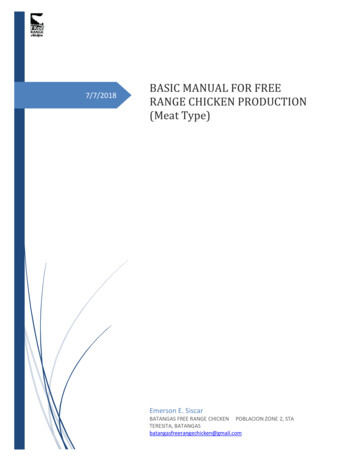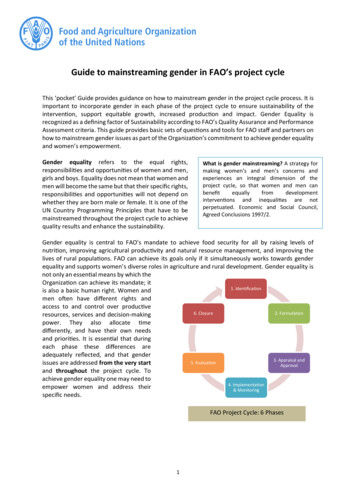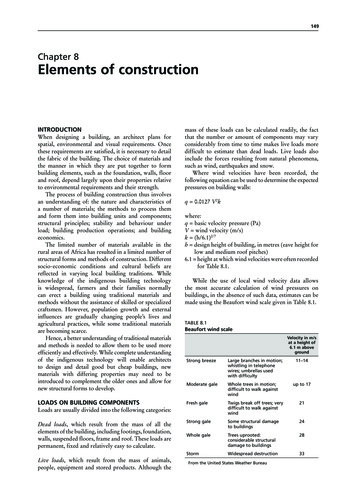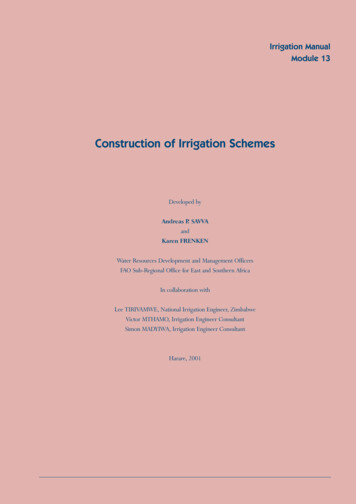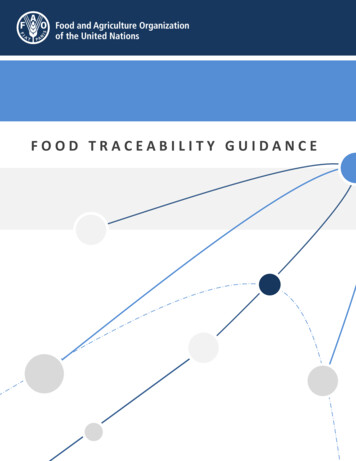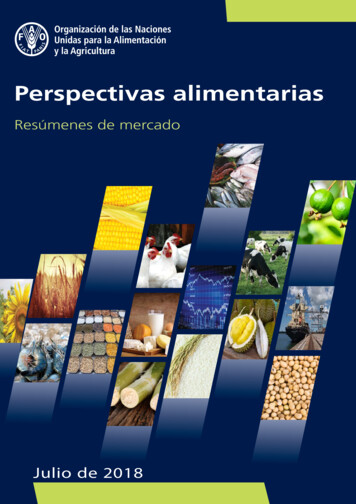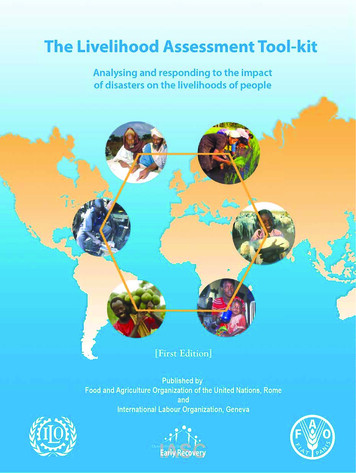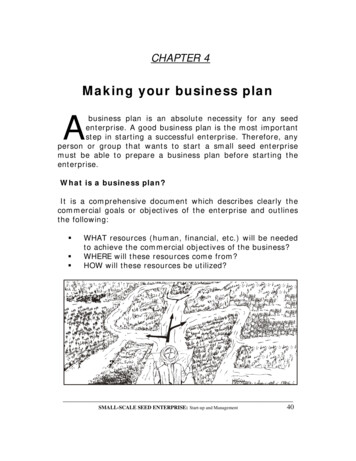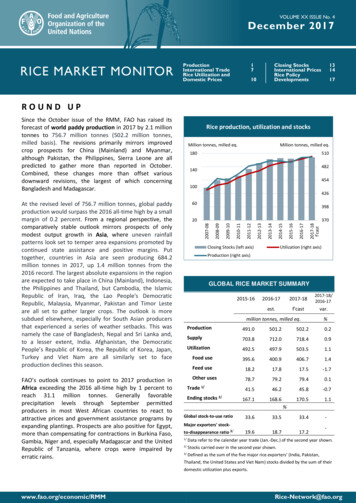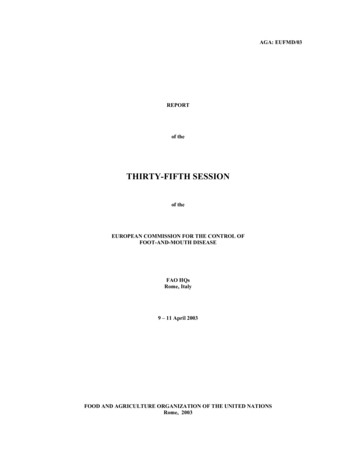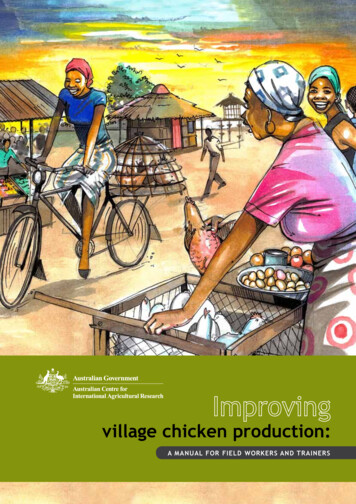
Transcription
village chicken production:a manual for field workers and trainers
village chicken production:a manual for field workers and trainersChristine Ahlers, Robyn Alders, Brigitte Bagnol,Ana Bela Cambaza, Mohamed Harun, Richard Mgomezulu,Halifa Msami, Bob Pym, Peter Wegener, Ed Wethliand Mary Young2009
The Australian Centre for International Agricultural Research (ACIAR)was established in June 1982 by an Act of the Australian Parliament.ACIAR operates as part of Australia’s international developmentcooperation program, with a mission to achieve more productiveand sustainable agricultural systems, for the benefit of developingcountries and Australia. It commissions collaborative research betweenAustralian and developing-country researchers in areas where Australiahas special research competence. It also administers Australia’scontribution to the International Agricultural Research Centres.Where trade names are used this constitutes neither endorsementof nor discrimination against any product by the Centre.ACIAR MONOGRAPH SERIESThis series contains the results of original research supportedby ACIAR, or material deemed relevant to ACIAR’s researchand development objectives. The series is distributedinternationally, with an emphasis on developing countries. Commonwealth of Australia 2009This work is copyright. Apart from any use as permitted underthe Copyright Act 1968, no part may be reproduced by anyprocess without prior written permission from the Commonwealth.Requests and inquiries concerning reproduction and rights shouldbe addressed to the Commonwealth Copyright Administration,Attorney-General’s Department, Robert Garran Offices, NationalCircuit, Barton ACT 2600 or posted at http://www.ag.gov.au/cca .Published by the Australian Centre forInternational Agricultural Research (ACIAR)GPO Box 1571, Canberra ACT 2601, AustraliaTelephone: 61 2 6217 0500aciar@aciar.gov.auAhlers C., Alders R.G., Bagnol B., Cambaza A.B., Harun M.,Mgomezulu R., Msami H., Pym B., Wegener P., Wethli E.and Young M. 2009. Improving village chicken production:a manual for field workers and trainers. ACIAR MonographNo. 139. Australian Centre for International Agricultural Research:Canberra, 194 pp.ISBN 978 1 921531 57 6 (print)ISBN 978 1 921531 58 3 (online)Technical editing by Clarus Design Pty LtdDesign by WhiteFoxPrinting by Goanna Print
ForewordPoultry have contributed to human health and wellbeing for millennia. For ruralcommunities, poultry continue to be an integral part of farming systems andhousehold economies. For cities and towns, where an increasing proportionof people now live, large- and small-scale commercial poultry industries playa critical role in providing safe, good-quality products for urban consumers.In many countries, commercial and household poultry are located within thesame communities, and improvement programs designed to increase thecapacity of producers and introduce new technologies and practices canhave widespread impact.Australia has supported the implementation of effective village chickenproduction programs in Asia, Africa and Latin America, including severalresearch projects funded by the Australian Centre for International AgriculturalResearch (ACIAR). This investment in research and development, alwaysin collaboration with producers, traders and other stakeholders, has beenshown to increase poultry numbers, household purchasing power, homeconsumption of chicken products (resulting in improved nutrition for families)and the decision-making power of women. Village chicken improvementprograms have the potential to contribute to each of the MillenniumDevelopment Goals and to do so for the most vulnerable families indeveloping countries.This is the fourth manual on improvements to village chicken productionsupported by ACIAR.1 These manuals aim to fill gaps in the training literature,which has dealt mostly with intensive commercial production or backyardproduction in developed countries. This manual is focused on developingcountries and describes husbandry practices and biosecurity measures forvillage chickens that can be implemented using locally available resources.These measures will lead to both increased productivity and improvedprotection from disease in village chicken systems.The manual is comprehensive, covering many aspects of production andhealth. It draws on the research results of a number of ACIAR-fundedprojects that provided a sustainable base to the control of Newcastle disease(ND) in village chickens using thermotolerant vaccine. Newcastle diseaseremains a major constraint to poultry production worldwide and these projectsrecognised that benefits to farmers can be further increased when otherhealth and production issues are tackled in addition to vaccination.Much of the content of the manual has been developed to this finalstage during a project funded by the Australian Agency for InternationalDevelopment (AusAID) from 2002 to 2005, to implement the Southern AfricaNewcastle Disease Control Project (SANDCP) in Malawi, Mozambique and1Controlling Newcastle disease in village chickens: field (Alders and Spreadbrow 2001), training (Alders et al. 2002)and laboratory (Young at al. 2002) manuals (ACIAR Monographs 82, 86 and 87, respectively)3
Tanzania. SANDCP followed on from 7 years of ACIAR-funded research onND control conducted by the Mozambican National Institute for VeterinaryResearch and the University of Queensland.It is pleasing to note that the success of SANDCP, including the use of thetraining material in this manual, has gone well beyond the control of ND inthese three countries and has laid a foundation for responding effectivelyto the worldwide epidemic of highly pathogenic avian influenza and indeveloping livelihood strategies for communities affected by high levelsof HIV/AIDS.ACIAR will continue to support research that contributes to food security,food safety and ecologically sustainable livestock production, and torecognise that building capacity in poultry health and production is ofspecial significance to developing countries.Peter CoreChief Executive OfficerACIAR4
ContentsForeword3About the PART 1 VILLAGE CHICKENS AND VILLAGE CHICKEN FARMERS151Introduction161.1Village chickens defined161.2About this manual171.3How to use this manual181.4Promoting improved village chicken production using minimalexternal inputs191.5Gender and village chickens221.6Newcastle disease and avian influenza control, and otherproduction improvements221.7Village chicken production and HIV/AIDS mitigation231.8Organic village chicken production231.9Village chicken production and wildlife conservation232General information about village chicken production252.1The village chicken system252.2Comparisons between village chickens and commercialchicken production262.3Production characteristics of village chickens272.4The scavenging feed resource base293 Working together with male and female village chicken producers3.1Introduction303.2Phase 1: Raising awareness and identifying problems313.3Phase 2: Identifying solutions and planning activities323.4Phase 3: Implementing activities333.5Phase 4: Evaluating the results33PART 2430HOUSING, NUTRITION AND MANAGEMENT35Chicken housing and shelter364.1Introduction364.2Types of housing364.3Constructing a chicken house384.4Roosts/perches384.5Maintaining a chicken house394.6Provision of nests394.7Protection from predators and theft415
56Nutrition435.1Water435.2Scavenging445.3How a chicken digests food455.4What chickens need in their feed465.5Feed resources485.6Supplementary feeding505.7Feedstuffs that might be offered to chickens, and their nutrient content 545.8Feeding confined chickens54Flock management576.1Keeping the flock healthy and productive576.2Flock size586.3General hygiene596.4Laying, brooding and hatching606.5Raising young chicks686.6Breeding726.7Meat production (sale and consumption)756.8Egg production (sale and consumption)806.9Record keeping887 Disorders related to poor husbandry or nutrition89PART 3 DISEASES AND THEIR CONTROL918 Disease in village chickens928.1Introduction928.2Causes of disease928.3Transmission of infectious diseases938.4Notifiable diseases948.5Diagnosis of poultry disease949 Disease control101029.1Introduction1029.2Tools used to control diseases in village chickens1029.3How to prevent a disease from entering a village chicken flock1049.4How to control a disease outbreak in a village chicken flock106Newcastle disease10810.1Cause and impact10810.2Transmission10810.3Species affected11010.4Clinical signs11010.5Post-mortem findings11210.6Field diagnosis of Newcastle disease11210.7Investigating vaccination failure11310.8Controlling Newcastle disease11410.9Reporting Newcastle disease11910.10 Differential diagnosis of Newcastle disease in village chickens6119Improving village chicken production: a manual for field workers and trainers
1112Other infectious diseases of village chickens12111.1Introduction12111.2Avian influenza (fowl plague)12311.3Chronic respiratory 11.6External parasites (fleas, mites etc.)13311.7Fowl cholera (pasteurellosis)13711.8Fowl pox13911.9Fowl typhoid14011.10 Infectious bursal disease/Gumboro disease14111.11 Infectious bronchitis14311.12 Infectious coryza14411.13 Infectious laryngotracheitis14511.14 Marek’s disease14611.15 Pullorum disease (bacillary white diarrhoea)14711.16 Internal parasites148Concluding remarks150Bibliography151Appendixes1551How to use this manual as part of a training course for livestock officers,extension agents, community animal health workers or farmers156Participatory community exercises for identifying problemsassociated with village chicken production1573Collection of blood samples1734Post-mortem examination1755Collection of samples for laboratory examination1836Sources of further information1942Contents7
About the authorsAuthorDescriptionContact detailsChristine AhlersA poultry veterinarian with1. FAO Regional Office for Asia andexperience in both commercial andthe Pacific, 39 Phra Atit Road,family poultry, working for the FoodBangkok 10200, Thailandand Agriculture Organization of2. Soomskamp 12, 27324the United Nations in its RegionalEystrup, GermanyOffice for Asia and the PacificEmail: c-ahlers@gmx.deRobyn AldersA village poultry specialist with the 1. KYEEMA Foundation, GPO BoxInternational Rural Poultry Centre3023, Brisbane, Queensland 4001,of the KYEEMA Foundation and theAustralia.Cummings School of Veterinary2. International Program, DEPH,Medicine, Tufts University, USACummings School of VeterinaryMedicine, Tufts University, 200Westboro Road, North GraftonMA 01536, USAEmail: robyn.alders@gmail.comBrigitte BagnolSocial anthropologist with theUniversity of the Witwatersrand,Johannesburg, South Africa andthe International Rural PoultryCentre of the KYEEMA FoundationPostnet suite 118 Private Box X1,Melrose Arch, 2076 Johannesburg,South AfricaEmail: bagnolbrigitte@gmail.comAna Bela Cambaza A veterinarian working for theNational Veterinary ServicesDirectorate who has been involvedwith the control of Newcastledisease in village chickenssince 2004.CP 1406, Maputo, MozambiqueMohamed HarunVeterinary physiologist specialisingin the biology of incubation andtemperature regulation in neonatesof avian speciesVeterinary Faculty, University ofEduardo Mondlane, PO Box 257,Maputo, MozambiqueAnimal production specialist with18 years’ experience in livestockproduction including poultry.He has been actively involvedin control of Newcastle diseasein village chickens using athermotolerant I-2 ND vaccinesince 2003.Department of Animal Health andLivestock Development, PO Box2096, Lilongwe, MalawiRichardMgomezuluHalifa Msami8Email: controlodn@yahoo.com.brEmail: kabil.harun@tvcabo.co.mzEmail: richardag mgomezulu@yahoo.co.ukPrincipal veterinary research officer, Central Veterinary Laboratory, POTanzania national coordinator forBox 9254, Dar Es Salaam, TanzaniaNewcastle disease control; poultryEmail: hmmsami@gmail.compathologist with several yearsexperience working on villagechicken developmentImproving village chicken production: a manual for field workers and trainers
AuthorDescriptionContact detailsBob PymA poultry geneticist by trainingwith interest and involvementin small-scale family poultryproduction in the developingcountries of South-East Asia andSouthern AfricaSchool of Veterinary Science,University of Queensland, St Lucia,Queensland 4072, AustraliaA community development andextension specialist who has alsohelped design training materialsand programs for the controlof Newcastle disease in villagechickensSchool of Natural and Rural SystemsManagement,University of Queensland,St Lucia Campus, Queensland 4072,AustraliaA poultry specialist with manyyears’ experience of small-scalechicken development in rural andperi-urban areasPO Box 171, Ifafa Beach 4185,KwaZulu-Natal, South AfricaA veterinary pathologist withseveral years’ experience in controlof Newcastle disease in villagepoultry using thermotolerant I-2Newcastle disease vaccineKYEEMA Foundation, GPO Box3023, Brisbane, Queensland 4001,AustraliaPeter WegenerEd WethliMary YoungAbout the authorsEmail: r.pym@uq.edu.auEmail: p.wegener@uq.edu.auEmail: edwethli@absamail.co.zaEmail: mary p young@yahoo.com9
AcknowledgmentsSincere thanks to go to the many farmers, extension workers, livestockspecialists and veterinarians who have contributed valuable informationand provided feedback on the contents of this manual.We acknowledge the support of the Australian Agency for InternationalDevelopment through the Southern Africa Newcastle Disease ControlProject (SANDCP) and the Australian Centre for International AgriculturalResearch in the preparation of this manual. Dr Ed Wethli was working asan International Fund for Agricultural Development consultant at the timehis contribution was made. SANDCP was implemented by GRM InternationalPty Ltd in collaboratio
This technique uses a needle and syringe, both of which can be washed for reuse, though the needle less often than the syringe: a 25 G (0.50 16 mm) needle is used

